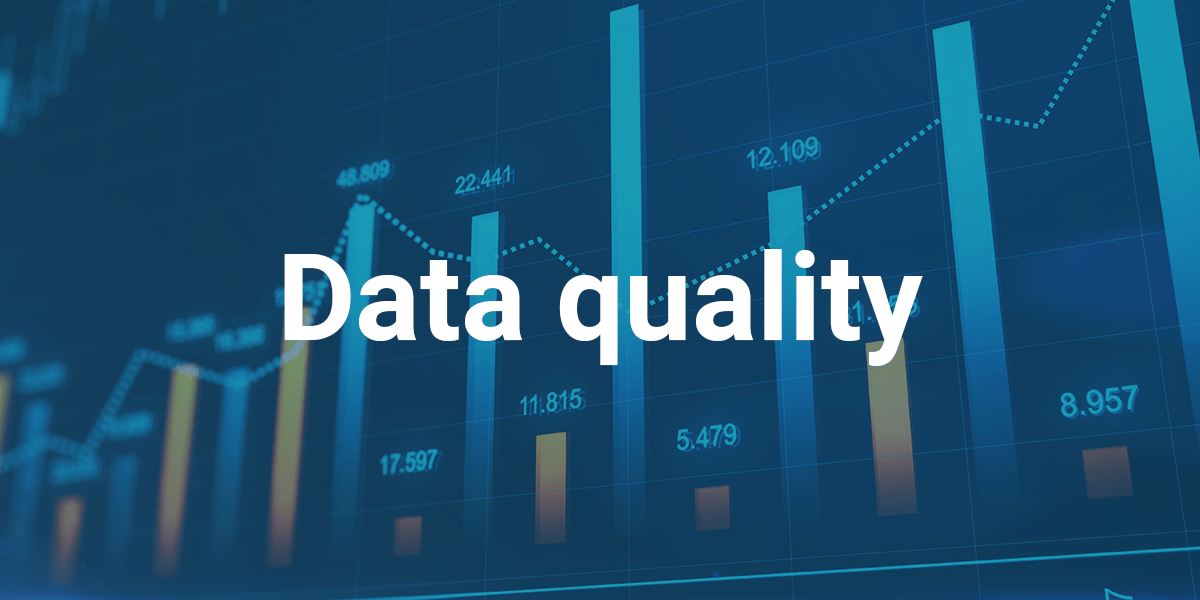In today’s digital world, data has become a “make or break it” factor for any company. Poor data quality can have disastrous effects on organizations. According to a recent Wakefield Research survey, it can impact over 25% of a business’s revenue.
Accurate data quality helps decision-makers make informed decisions and:
- Achieve their goals
- Build successful business strategies and processes
- Integrate artificial intelligence (AI) and automation into their workflows
This article will help organizations to get the most out of their data. It will explore the importance of data quality and everything organizations need to know to create a winning strategy.
Data Quality Strategy: Table of Contents
What is Data Quality
Data quality defines how well a set of data meets the requirements and purpose of its use in a real-world scenario. High standards empower organizations to leverage trusted information to:
- Improve decision-making
- Drive business growth
- Minimize the risk of losses caused by incorrect or missing data
Data Quality Vs. Data Integrity: The Difference At-A-Glance
Ensuring data quality is critical for all those tasks requiring reliable data. Relevant and accurate data are the base of successful analysis, business intelligence (BI) and reporting.
Data integrity is another pivotal aspect of data-driven organizations. Yet, it focuses solely on:
- Data security (i.e., protecting digital information)
- Unauthorized data modification
- Protecting data from corruption
The 7 Data Quality Dimensions
The quality of data is measured and defined by multiple metrics (i.e., dimensions). These dimensions may slightly differ, depending on the context. Here is a list of the most common data quality dimensions.
- Completeness. Indicates if the necessary information is available and complete. For instance, incomplete customer feedback could lead to incorrect customer and product insights. Missing cost-related information could result in inaccurate budget forecasting.
- Uniqueness. Enables organizations to reduce duplicates and overlaps of data. Delivery issues are less likely to happen when each customer’s order has its unique number.
- Validity. Identifies data structure problems and verifies the compliance of values with specific standards. For example, calendar dates are valid only if they match the standard format (e.g., year, month, day in the case of the U.S.).
- Timeliness. Verifies that the data analyzed is current and available when needed. A customer booked a flight online? The booking confirmation should happen in real time, just after the payment.
- Accuracy. Attests the correctness of the data extracted from a data source (e.g., a database). An example? Inaccurate customers’ postal addresses. Without improving data quality and accuracy, it could cause delivery issues.
- Consistency. Demonstrates that the same information coming from different data sets matches. Let’s take employees’ home addresses stored by HR and payroll. Conflicting data could cause payment and compliance issues.
- Fitness for purpose. Helps data consumers evaluate whether new datasets meet a business need. For instance, data is at the basis of modern healthcare. This is why decision-makers highly rely on it to evaluate real-world data (i.e., data coming from real patients and hospitals).
Why is Data Quality Important
According to the 2023 Data Integrity Trends and Insights Report, data quality is the top concern for 70% of firms that do not trust their data. And they are not wrong. Relying on untrustworthy data may have devastating consequences including, but not limited to:
- Wasted resources and time. Caused by focusing on the wrong priorities.
- Lower customer trust. Driven by negative customer experiences.
- Financial loss in the form of penalties/legal actions. Triggered by failing to comply with data privacy regulations. The General Data Protection Regulation (GDPR) and the California Consumer Privacy Act (CCPA) are two typical examples.
- Missed customers, opportunities and revenue. Generated by targeting the incorrect customer groups.
On the other hand, companies using high-quality data that meet some (or all) dimensions of data quality will enjoy a series of advantages. Among them:
- Resource optimization and increased productivity. By enabling teams to identify and correct workflows and optimize supply chain operations.
- Enhanced customer trust. By ensuring compliance with regulations and improving customer-related processes.
- Minimized losses. By reducing operational errors and workflow interruptions.
- Higher revenue and conversions. By harnessing the power of trustworthy analytics (e.g., shopping behavior analysis, marketing funnels, effective BI dashboards).
How to Measure
Organizations validate the quality of their data using different methodologies (e.g., frameworks) and data quality dimensions.
For instance, the International Monetary Fund (IMF) bases its data quality assessment framework (DOAF) on:
- Data integrity
- Methodological soundness
- Accuracy
- Reliability
- Serviceability
- Accessibility
Unicef ensures data quality following a DOAF focusing on several other dimensions (e.g., interpretability and timeliness).
Once a firm has identified its ideal dimensions of data quality, can move on to the next steps of the process such as:
- Run subjective data quality assessments. Understand how data consumers and stakeholders (i.e., the persons impacted or invested in a project) perceive the quality of the data.
- Assess objective data quality metrics to look at measurable indications within a dataset.
At the end of both evaluations, the organization will have enough information to:
- Identify areas of improvement
- Build or enhance a comprehensive data quality strategy.
How to Build an Effective Strategy
A 2021 Gartner study estimates the average cost of poor data quality of $12.9 million per year. Implementing a well-defined strategy will reduce or even eliminate those costs.
A successful strategy always starts with a strong business case. Describe the numerous benefits of state-of-the-art data quality management and build top-notch by:
- Obtaining the stakeholders’ support.
- Establishing metrics and service level agreements (SLAs) to set goals and track progress.
- Launching a data stewardship program to ensure the data is accessible, usable and accurate.
- Building and automating a data governance model. A set of rules and standards promoting the availability and quality of data.
- Developing a communication plan to promote the importance within the organization.
How to Improve Data Quality
No matter which data quality management tools businesses choose to use to improve the quality of their data, they must:
- Assess the current state of the data available. Find out where it is stored, how sensitive it is (e.g., health information) and if there are any issues.
- Invest in data quality management tools. Consolidate and automate data using tools like those offered by Infoverity. The Master Data Management (MDM) solution and the Infoverity Customer Data Platform (CDP) automate data collection, enable advanced analysis and facilitate data governance.
- Create rules and integrate them across all data sources. Use those tools to prevent, monitor and report data quality issues and validate and cleanse data automatically.
- Continuously monitor and report all data-related activities. Dashboards, scorecards and graphics enable firms to easily monitor and analyze any kind of data.
- Identify and implement corrective actions. It will ensure ongoing compliance with data quality standards and prevent problems.
Want to know more about MDM?
Download our free ebook or watch the short video here to discover what Infoverity MDM can do.
3 Key Benefits of Improved Data Quality
In today’s digital world, competition reigns. That is why data-driven decision-making is essential to the success of any enterprise.
Moreover, a recent LXT report confirms that 87% of enterprises using AI are willing to invest big money to obtain high-quality training data. Why? Because they know very well that, among other benefits, accurate and high-quality data:
- Improves return on investment (ROI)
- Enhances product development
- Revolutionizes businesses’ marketing strategies
And it does not stop here. High-quality data ameliorate operational workflows while boosting customer and employee experiences.
Let’s take the supply chain industry as an example. Reliable, real-time data facilitates streamlined processes and reduces shipping delays.
As a result, the operational costs decrease while overall customer satisfaction increases.
Good data quality provides valuable target buyer insights to marketing and sales teams. It leads to effective communication and correct marketing budget allocation.
In a nutshell, improved data quality lets organizations thrive and enjoy a few perks. Among others:
- Outstanding Business Decisions. Clearly defined key performance indicators (KPIs) facilitate team improvement, focus, and efficiency.
- Sleek Business Processes. Reliable and up-to-date data result in more efficient workflows. No more last-minute data hunting or fixing.
- Exceptional customer and employee experience. In a customer service environment, accessible and trustworthy data benefits both employees and customers. They eliminate costly errors and frustrating long wait times on the phone.
Conclusions
These days, high-quality data is the new currency. And it is critical to any organization’s business success. That is why a poor quality of data can have detrimental consequences on any organization.
Decision-making, process efficiency, productivity and customer experience. Every aspect of the business will suffer.
Stand out from the crowd and achieve superior business results. Prioritize and share the accuracy and trustworthiness of data across departments.
Save money and resources. Start your data-driven journey with a bang and unleash the power of high-quality data now.




